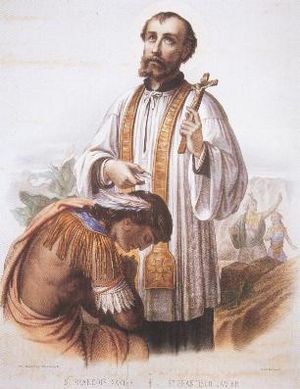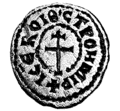Christianization facts for kids

Christianization is the process of people or entire groups becoming Christian. This happened a lot from ancient times through the Middle Ages. Different ways were used to spread Christianity. Sometimes, if a ruler became Christian, everyone he ruled had to become Christian too.
Other times, monks or priests would teach people about Christianity. It also grew naturally in places where some people were already Christian. Sometimes, old pagan temples were turned into Christian churches. Pagan gods and practices were also often changed or replaced.
A clever way to spread Christianity was called interpretatio christiana. This meant taking old pagan traditions, images, places, and even holidays and giving them new Christian meanings.
This idea of changing old traditions to fit Christian beliefs was officially allowed. For example, Pope Gregory I wrote a letter to Mellitus, a missionary. He said it was easier to convert people if they could keep some of their old traditions. The key was to say these traditions now honored the Christian God. This way, people felt more comfortable changing their beliefs. The traditions stayed, but their meaning changed.
Contents
How People Became Christian
Spreading the Faith
Christianity spread in many ways over hundreds of years. Missionaries, like monks and priests, traveled to new lands. They taught people about Christian beliefs. Sometimes, large groups of people decided to become Christian together.
Rulers and Their People
A common way for an entire area to become Christian was when its ruler converted. If a king or queen became Christian, their subjects often had to follow. This sometimes meant everyone in the kingdom was baptized, even if they didn't fully understand or believe yet.
Changing Old Ways
Christianization also involved changing existing cultures. Old temples were often reused as Christian churches. Festivals and traditions from older religions were sometimes given new Christian meanings. This helped people feel more comfortable with the new faith. It made the change feel less sudden and more familiar.
Old Traditions, New Meanings
What is Interpretatio Christiana?
Interpretatio christiana is a Latin phrase that means "Christian interpretation." It was a smart way to help people switch from their old religions to Christianity. Instead of completely getting rid of old customs, they were changed. They were given new Christian meanings.
Examples of This Idea
Imagine an old tree that people once worshipped. Instead of cutting it down, Christians might build a small chapel next to it. Or, a pagan holiday celebrating the sun might become a Christian holiday celebrating Jesus, who is sometimes called the "light of the world." This made it easier for people to accept the new religion. They could still do familiar things, but with a new understanding.
Pope Gregory's Advice
Around the year 600 AD, Pope Gregory I gave important advice about this. He told a missionary named Mellitus not to destroy pagan temples. Instead, he suggested turning them into churches. He also said that if people had feasts for pagan gods, they could still have feasts. But now, these feasts would be in honor of Christian saints. This made the change smoother for many communities.
Images for kids
-
Constantine's conversion, by Rubens.
-
Statue depicting the baptism of Clovis by Saint Remigius.
-
Basil I with delegation of Serbs
-
Introduction of Christianity in Poland, by Jan Matejko, 1888–89, National Museum, Warsaw
-
Image of the King Saint Stephen I of Hungary, from the medieval codex Chronicon Pictum from the 14th century.
-
According to Heimskringla, During the Christianization of Norway, King Olaf Trygvasson had male völvas (shamans) tied up and left on a skerry at ebb (woodcut by Halfdan Egedius (1877–1899).
-
Danish Bishop Absalon destroys the idol of Slavic god Svantevit at Arkona in a painting by Laurits Tuxen
-
San Pedro de la Nave, one of the oldest churches in Spain.
-
Depiction of the Battle of Navas de Tolosa by 19th-century painter Francisco de Paula Van Halen.
-
Ivory diptych of a priestess of Ceres, defaced and damaged by Christians
-
The Baptism of Kievans, a fresco by Viktor Vasnetsov
See also
 In Spanish: Cristianización para niños
In Spanish: Cristianización para niños





















